The girls are at it again! Buzzing, foraging,
…occasionally stinging (only when I invade their space), and making masses of ooey, gooey, delicious honey.
Not long ago, in response to the bees filling up their second boxes and working diligently on combing out their third boxes, Bee Daddy and I decided that it was time to extract some honey from the hives, giving the ladies a bit more elbow room to do their bee thing.
We checked both Mufasa and Scar and all seems well.
In fact, they’re growing quite a bit this summer; lots of capped brood and squishy larvae in all sizes. Both queens are laying eggs out the wazoo for the next generation of workers and this generation of workers are moving the honey production (and everything else they do) right along.
However….
See these dark, round beetles on the side of the box and scattered amongst the bees on the top?
They’re Small Hive Beetles, Aethina tumida, an invasive pest of honeybees and scourge of honeybee keepers. They were obviously skedaddling away as we smoked and opened the hives. I didn’t even see them in the photo until I was placing the copyright, but the devils were there, planning their evil takeover of the hives. I’ll be posting more about them another day, but I just wanted you to get a good look at these bad bugs. BAD BUGS!!
We opened the hives in late June,
…and saw lots of bee activity and comb galore.
Gorgeous, honey-filled comb! I’m hungry.
When we extract, we always leave some full comb and rearrange the bars so that there’s one full bar with comb adjacent to another bar without full comb, in a checkerboard fashion. This gives the girls room to maneuver and work on combs throughout the box. The checkerboard also allows us easier access when checking the hive.
Because our Warre hives use top bars and no frames, our bees make interesting comb at times.
This comb looks like the girls just came out of geometry class after learning how to make circles, and wanted to practice and show off their new skills.
Extracting comb is messy. When I do it, anyhow. This time, some honey spilled. These gals went down in a goo of glory.
A few bees went for it and, well, a sad end, but what a way to go!
As I gain experience with this beekeeping nonsense, I wised up and rather than cutting the comb and stuffing it into resealable bags, covering myself and everything else in honey, I’m now using reusable plastic containers.
Duh. I don’t know why I didn’t think of that before, but my life is now easier on extraction days. Equipment readied,
…and here’s the final product. Ta da!! We extracted just under one gallon of honey.
Can you guess which is the spring honey? If you shouted The left one!! The left one!! (and your family members are now looking at you with concern), you’d be right. Other than bees take honey from different flowers at different times of the year, I haven’t quite nailed down the reason why our spring honey is lighter and more liquid than the fall honey. The jar on the right is the last of the fall honey, which we’ve almost finished, and it’s remarkable how different the two kinds are. Of course, I know what the bees are foraging from my gardens, but they travel upwards to three miles, so I have no idea of the entirety of what makes up the honey product Funny story: at one of the first beekeeping meetings we attended, another beekeeper mentioned that a local university will test for nectar sources of honey samples. A friend sent honey to this university and the top nectar source was a non-native plant (I don’t recall what) and the second source was cannabis. A woman raised her hand and asked where she could buy that honey.
Honey does taste different–depending upon nectar sources and time of year. Both the fall and spring honey from my darling bees is exquisite–it tastes nothing like what’s sold at stores. The fall is richer and thicker and the spring is lighter, more fluid. I’m guessing that there’s some evolutionary reason behind the thicker fall honey. After all, the bees create it to sustain themselves during the long winter and it makes sense that fall blooming flowers might have a richer nectar component than at other times of the year. But truthfully, I have no idea. I’m just going to enjoy both spring and fall honey, weight gain notwithstanding.
After I crush the comb and extract the honey, I always leave it out for the bees to clean up. They’re quite efficient and gobble every last drop of honey I missed.
To quote from a favorite movie of mine, said by the character played by James Stewart in The Philadelphia Story: The queen will have bread and honey at the usual time.

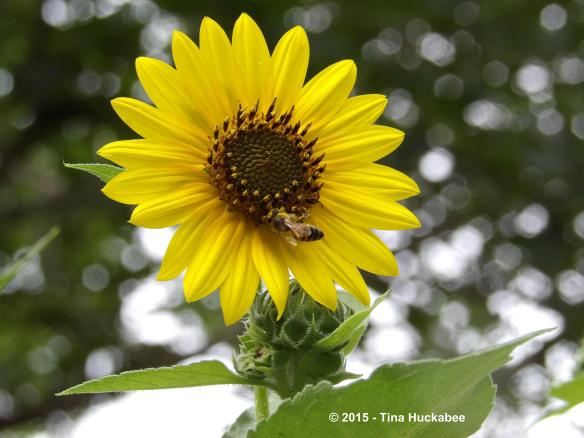
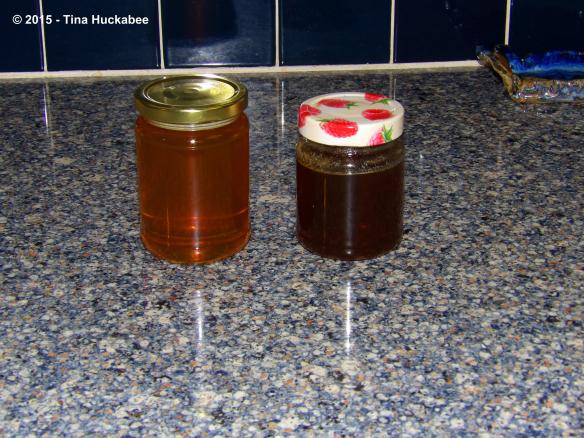
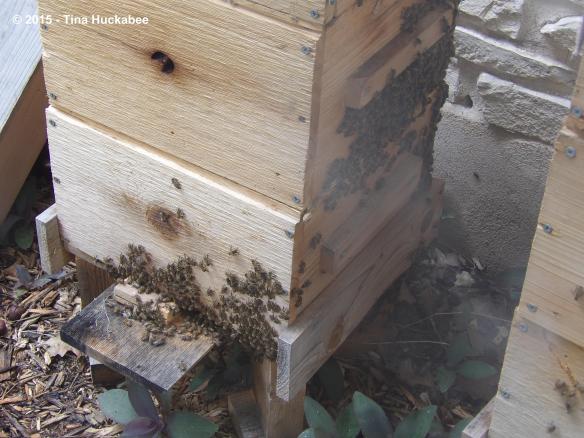

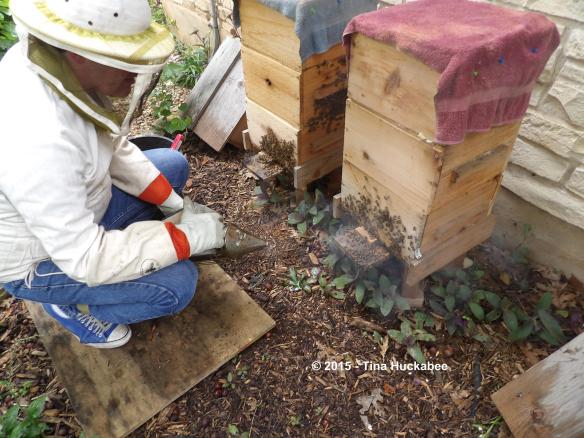
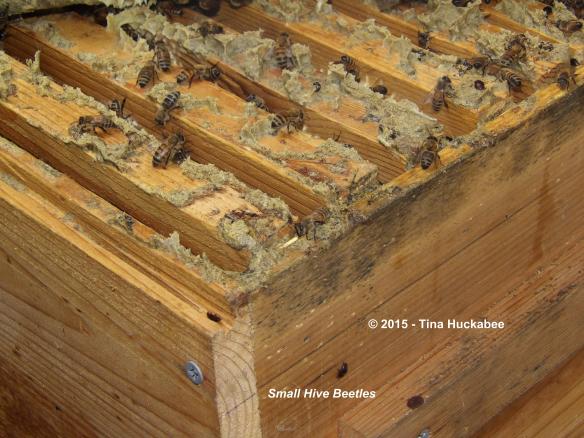
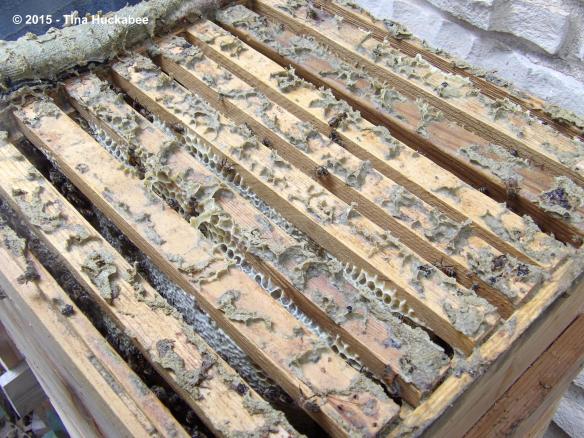
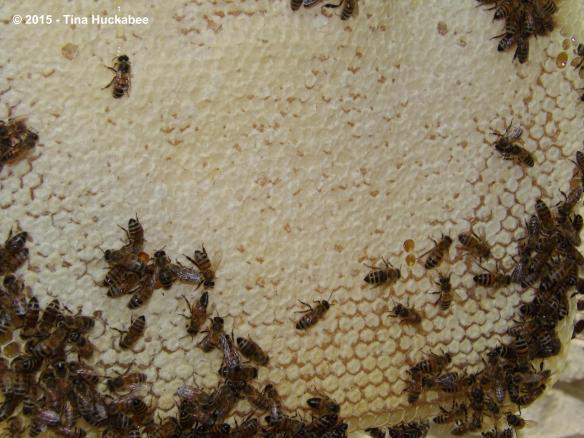
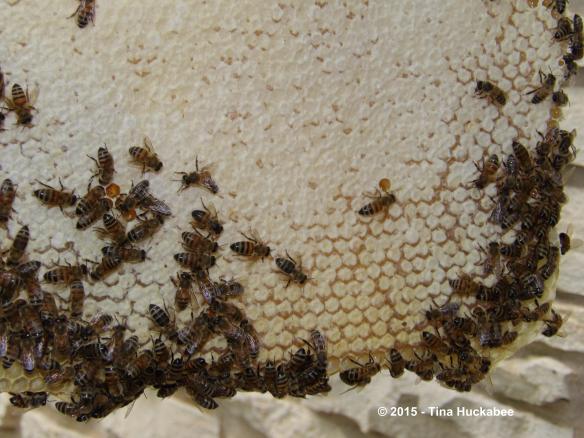
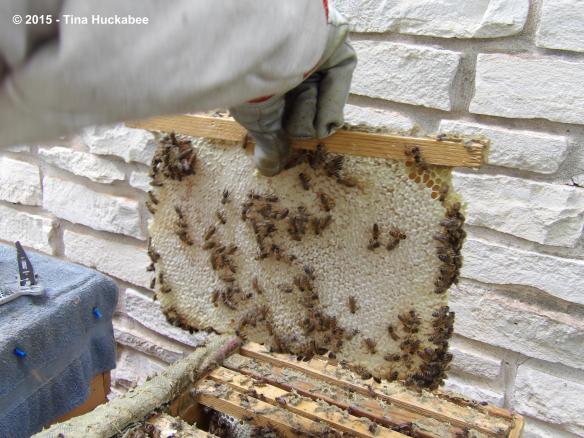
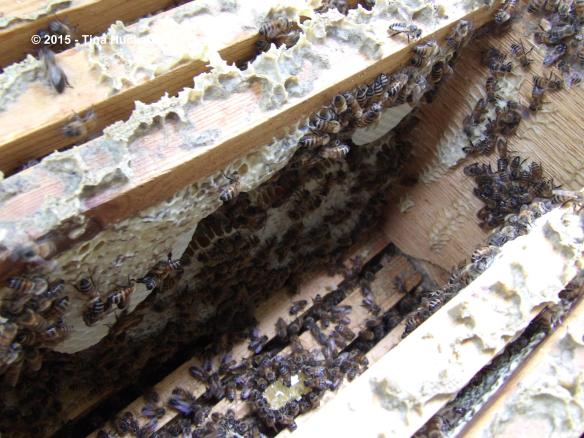
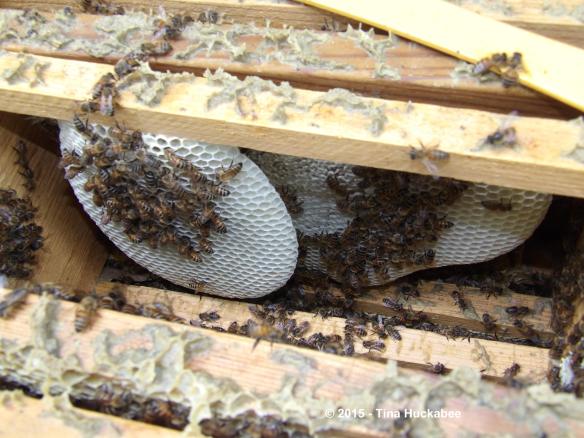
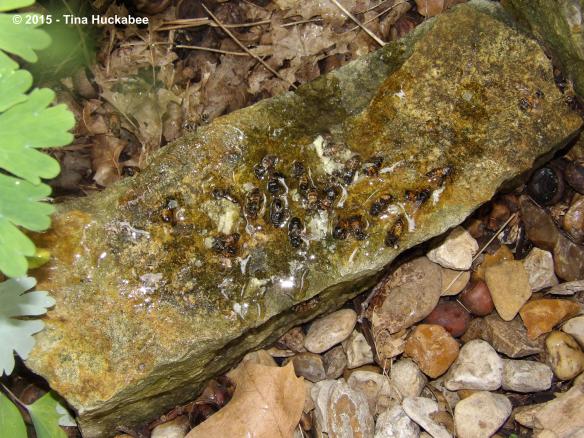
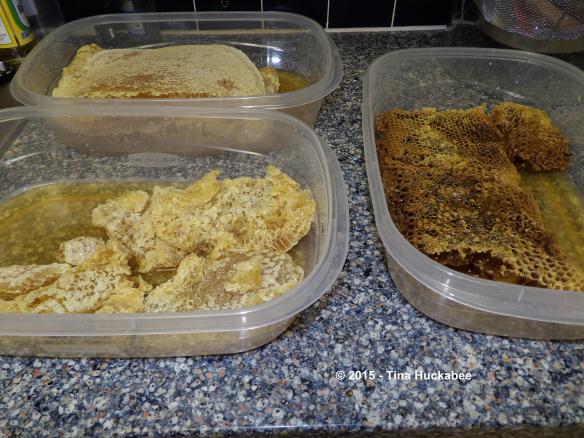
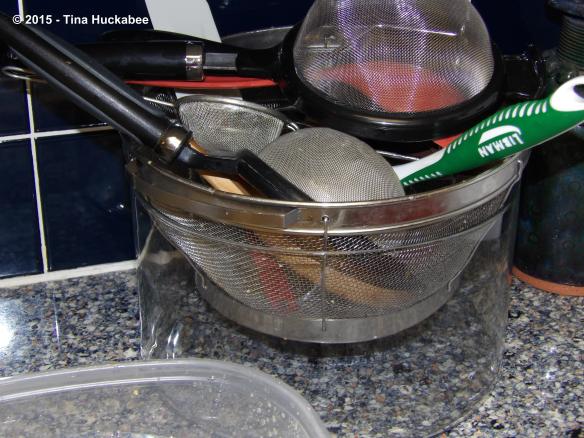
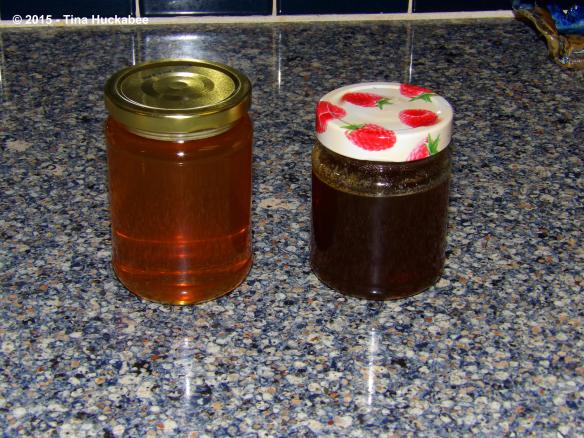
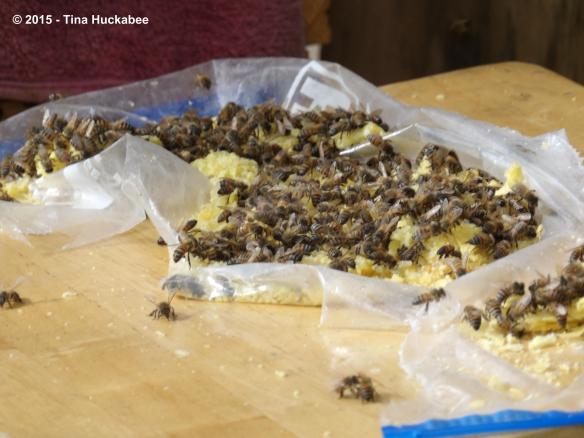

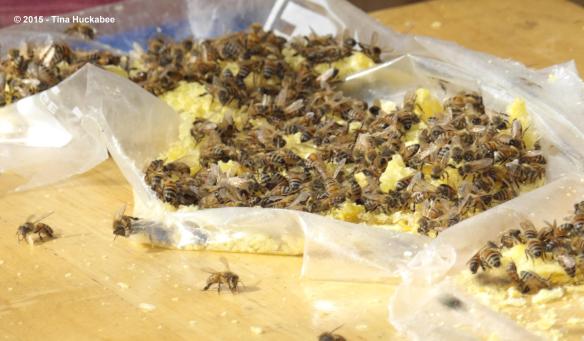
Ha ha – at first in those photos towards the end of the post where the bees are cleaning up the honey from the extracted comb I thought they were indoor shots and I was “Whoa Tina! I know you love your bees but INSIDE the house? REALLY?!?”. I see now that table is outside. Ahem.
That’s a hilarious story about the nectar sourcing results. I wonder if the bees are or were affected by the pharmacological properties of the cannabis? I read somewhere bees get addicted to nicotine pretty promptly and I’ve seen intoxicated butterflies on fermenting fallen fruit… Do you suppose when those bees got back to the hive their locator dance was especially, well, funky?
Those circular combs are amazing. Bees!!!
LikeLike
They do get into the house, though not in those numbers. 🙂 I placed the crushed comb on some old standing trays that I have; a good use for them, as before, they were just dust collectors.
As for the “pharmacological properties” –I could see the bees gazing at their wings, all buzzing: Wow….
LikeLiked by 1 person
You have your own bee hive! That is incredibly cool. I can believe that your honey is especially delicious.
LikeLike
Actually, we have two bee hives!! Scar and Mufasa, meet Mr. Gardenacity–Mr. Gardenacity, meet Scar and Mufasa! Bees are incredibly cool!!
LikeLiked by 1 person
Lovely stories and a great product. I like that you give the bees the honeycomb back to finish off the honey. Efficient.
LikeLike
Efficient and fair, I think. After all, they made the stuff and there’s only so much I can squeeze out. It would be a terrible waste to throw it away!
LikeLike
Hurrah for bees! And hurrah for this really fun post. I too thought those photos were inside shots for some reason and I was marvelling. Love the cannabis honey story. hahaha And the beautiful circular comb. I can attest to the delicious quality of your bee’s honey. mmmmm (and once again thank you so much for sharing your treasure.) Boo to the beetles.
LikeLike
That cannabis story never fails to get chuckles. That’s funny about the photos looking like they were taking inside my house. I would be even more of a nutjob if I invited the bees in. Actually, if I had honey for them to eat, they’d would be so engrossed in that, they wouldn’t want to look around too much.
Isn’t that circular comb a wonder? Boo to the beetles, indeed. I set traps yesterday for them. More about that soon….
LikeLike
Fabulous honey…love seeing the bees working and those honeycombs are wonderful!
LikeLike
Beautiful, right?
LikeLike
Gosh, I really enjoy these updates on your hives! It’s good to know the bees are healthy and happy, and I learn so much each time as you explain your experiences. Thanks!
LikeLike
I’m glad you’ve enjoyed the bee news. It’s been a fun trip with the bees.
LikeLike
Lovely post. I miss my bees but not the sticky kitchen after I had finished extracting. Interesting about the Cannabis honey, I wonder if it would have the same effect as the ‘ mad honey’ made from pollen collected from Rhododendron luteum.
LikeLike
The honey seems to get everywhere and I never can figure out how. One wonders if insects enjoy more plants than others….
LikeLike
Honey! MMMMMMM. What a wonderful “hobby”? I think it’s fantastic that you have bees. Thanks for sharing the gooeyness.
LikeLike
It’s interesting and delcious!
LikeLike
I love the bee updates. I wonder where the honey bees are located that come into my garden. I am going to look up those bugs you mentioned… Michelle
LikeLike
Your apis visitors are probably within a mile or two. The small hive beetles are nuisance insects, but can destroy hives that are weakened.
LikeLike
Such a great and rewarding hobby! Lots of work involved but the end product is so delicious 🙂
The circular comb is quite amazing – fantastic creatures.
LikeLike
It’s been very rewarding, this bee thing. 🙂
LikeLike
That honey looks delicious! Pretty interesting that you get such different flavored honey depending on the time of year and flowers in bloom. I wonder how much the spring honey or fall honey varies year to year depending on a higher abundance of certain blooms.
LikeLike
Honey is very reflective of what’s growing, I’ve learned. I’ve met beekeepers who want to sell honey that is produced in very specific ways, ie., specific to native plants/wildflowers–much like beer brewers who want their beer to have a particular taste. The only problem is that bees need a 3 mile radius for foraging vs. beer brewers who just need their kitchen and ingredients.
LikeLike
Pingback: Bee Mama Missive: Beetles Bee Damned | My Gardener Says…